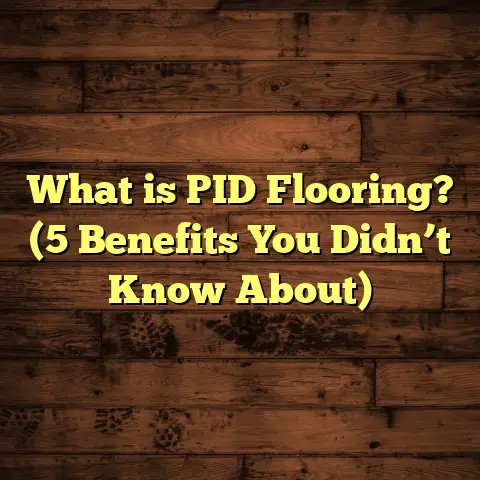What is Hardwood Floor Refinishing? (5 Benefits You Must Know!)
Myth: Hardwood floors are too fragile to be saved once they show wear and tear.
I used to believe that myself. The deep scratches, dark stains, and faded color on my old hardwood floors looked like permanent damage. I thought the only solution was ripping everything out and starting fresh, which sounded exhausting and expensive. But then I learned about hardwood floor refinishing—and it changed how I see my floors and home maintenance forever. If you’ve been staring at your worn floors wondering if there’s hope, I want to share everything I know about refinishing. It’s more than just a facelift—it’s about preserving one of the most valuable parts of your home.
What is Hardwood Floor Refinishing?
Hardwood floor refinishing is the process of rejuvenating hardwood flooring by removing the top damaged layer through sanding, repairing minor imperfections, and applying new finish coats to protect and enhance the wood’s natural beauty.
Essentially, it’s like giving your floors a fresh start without replacing them. Sanding down removes scratches, scuffs, old finish, and stains. Then you have the option to change the wood’s color with stain or keep it natural. Finally, a protective finish is applied to guard against future damage.
How Does Refinishing Differ from Other Floor Treatments?
You might hear terms like recoating, screening, or resurfacing thrown around. They’re different from full refinishing:
- Recoating means applying a new finish layer over the existing one without sanding deeply. This can refresh shine but won’t fix deep scratches.
- Screening and recoating lightly abrades the surface and applies a new finish. It’s good for minor wear but not for restoring damaged floors.
Refinishing involves completely sanding down to bare wood (or near bare) before starting fresh. This makes it ideal for floors with serious damage or worn-out finishes.
Why Should You Consider Refinishing Your Hardwood Floors?
From personal experience and many projects I’ve worked on, refinishing is one of the best ways to preserve and enhance hardwood flooring. It’s not just about looks—it impacts your home’s value, air quality, and longevity.
Let me walk you through five key benefits that will make you rethink your floors.
1. Restores the Beauty of Your Floors
When I first started working with hardwood floors professionally, I was struck by how transformational refinishing can be. Floors suffering from years of wear—dullness, scratches, discoloration—can look almost brand new after a proper refinishing job.
One project stands out clearly: A client had 15-year-old oak floors that were scratched in every corner, with faded spots where sunlight hit for hours daily. After sanding off the damaged finish and applying a warm amber stain followed by a satin polyurethane topcoat, the floors looked radiant. The grain patterns popped beautifully, and the whole room felt brighter and more inviting.
According to the National Wood Flooring Association (NWFA), refinished hardwood floors can recover up to 90% of their original appearance. That’s impressive when you consider that replacing floors entirely can cost thousands.
What Makes Hardwood Floors So Beautiful?
Hardwood has unique grain patterns and natural color variations that give your home character. Over time, finishes fade or yellow, hiding this beauty under layers of wear. Refinishing reveals the wood beneath and lets its natural charm shine again.
How Does Refinishing Bring Out This Beauty?
Sanding removes the top damaged layer—scratches, stains, old varnish—and smooths the surface. Staining adds depth or changes color to match your style. Finally, finishing protects and adds sheen (matte, satin, or glossy) based on preference.
It’s a little like cleaning a foggy window so light can pour back in.
2. Increases Property Value
If you’re thinking about selling your home, refinishing hardwood floors is one of the smartest investments you can make. Homes with well-maintained hardwood floors consistently sell faster and command higher prices compared to those with damaged or carpeted floors.
A Remodeling Magazine report found that refinishing hardwood floors has an average return on investment (ROI) of about 70%. This means that if you spend $3,000 refinishing your floors, you might add approximately $2,100 to your home’s value.
Real-Life Example: Selling with Refinished Floors
I worked with a family who was on the fence about whether to refinish their 25-year-old maple floors before listing their home. The floors were dull with deep scratches from pets and kids. After refinishing, the clients said their home felt fresher and more appealing—something they couldn’t have achieved with carpet or laminate.
Within a week of listing, they received multiple offers above asking price. One buyer specifically mentioned how much they loved the hardwood floors as a selling point.
This experience isn’t unusual—buyers are drawn to homes with beautiful hardwood because it signals care and quality.
3. Improves Indoor Air Quality
You may not think about it often, but old hardwood floors can trap dust mites, pet dander, pollen, and other allergens in scratches and cracks. Over time, this buildup can contribute to poor indoor air quality.
When I refinish floors, I always notice how much dust comes up during sanding—this is all the trapped particles being removed along with the old finish.
Why Does This Matter?
For anyone with allergies or respiratory issues like asthma, cleaner floors mean healthier air inside your home.
One client with severe allergies told me after we refinished their floors that their symptoms improved noticeably. They could breathe easier without carpets or damaged finishes holding onto allergens.
Compared to carpeted rooms—which are notorious for trapping allergens—refinished hardwood offers a cleaner alternative that’s easier to maintain.
4. Extends Floor Lifespan
Many people don’t realize how long hardwood floors can last if cared for properly. Refinishing is key to extending their useful life by many years—even decades.
From what I’ve seen working on various homes, most solid hardwood floors can be refinished 3-5 times over their lifetime before needing replacement. This means if you refinish every 7-10 years depending on wear levels, your floor could last 50+ years!
Cost Savings Over Time
Consider this: replacing hardwood flooring costs between $8 – $15 per square foot (or more if you choose premium wood). Refinishing usually runs $3 – $5 per square foot.
If you refinish instead of replace every decade or so, you save thousands while keeping your floor intact.
For example, in a 1,200 square foot home:
- Replacing hardwood: $9 x 1,200 = $10,800
- Refinishing: $4 x 1,200 = $4,800
That’s a $6,000 difference saved each time you refinish rather than replace.
5. Allows Customization
One unexpected benefit of refinishing is how much control you get over your floor’s look during the process.
Maybe you’re tired of honey-colored oak and want something more modern like gray or espresso stain. Or perhaps you want to switch from a glossy finish to matte for a softer appearance.
With refinishing, staining lets you change color without pulling out boards or laying new flooring.
I remember working with a couple who remodeled their living room into a contemporary space. They wanted their traditional oak floors to match the new décor but didn’t want replacement hassle or cost. We sanded down their old finish and applied a dark charcoal stain followed by a satin finish—they loved how it transformed their entire room’s vibe.
My Personal Hardwood Floor Refinishing Journey
Let me tell you about my first big refinishing job—it taught me so much about why this process matters beyond just aesthetics.
A client had inherited an old farmhouse built in the 1940s with original heart pine floors that were covered in decades of grime and old varnish. The floors were scratched badly from years of use and had water stains from leaks upstairs.
When we began sanding with industrial equipment (which is noisy and dusty—brace yourself!), layers of dirt came off revealing stunning warm wood tones beneath.
Applying three coats of durable polyurethane added a soft sheen while protecting from future damage.
The client was thrilled—not only because we saved them from replacing expensive historic flooring but because their home finally felt warm again.
That project showed me how refinishing preserves history while refreshing your living space—a balance many homeowners appreciate more than they realize.
The Step-by-Step Process of Hardwood Floor Refinishing
If you’re curious what actually happens during refinishing, here’s an overview based on my work experience:
Step 1: Preparation
- Remove furniture and rugs from the area.
- Repair any loose boards or nails.
- Fill gaps or holes with wood filler.
- Clean floors thoroughly.
Step 2: Sanding
- Use a drum sander for large areas.
- Edge sanders clean corners.
- Multiple passes remove old finish down to bare wood.
- Dust collection systems help reduce mess but expect some dust.
Step 3: Staining (Optional)
- Apply stain evenly if changing color.
- Allow drying time as per product instructions.
- Choose from natural wood tones to darker hues or trendy grays.
Step 4: Finishing
- Apply protective coats (usually polyurethane).
- Can be oil-based (durable but strong odor) or water-based (low odor).
- Typically 2-3 coats with drying time in between.
- Buffing between coats ensures smoothness.
Step 5: Curing & Cleanup
- Let floor cure for several days before heavy use.
- Clean up dust and materials.
- Move furniture back carefully using pads to avoid scratches.
How Does Hardwood Floor Refinishing Compare to Other Restoration Options?
| Method | Cost Range (per sq ft) | Longevity | Appearance Result | Disruption Level | Suitable For |
|---|---|---|---|---|---|
| Hardwood Floor Refinishing | $3 – $5 | 10-20 years | Restores original wood look | Moderate (dusty & noisy) | Worn/damaged solid wood |
| Floor Replacement | $8 – $15+ | 30+ years | Brand new floor | High (removal & install) | Severely damaged/aged floors |
| Recoating/Screen & Recoat | $1 – $3 | 3-5 years | Slightly refreshed | Low (minimal sanding) | Minor surface wear |
| Floor Coatings (Polymer) | $2 – $4 | 5-7 years | Surface protection only | Low | Protecting new floors |
| Laminate Flooring | $1 – $4 | 10-15 years | Simulated wood look | Moderate | Budget-friendly alternative |
Refinishing hits a sweet spot between cost-effectiveness and quality restoration when your floors have surface damage but are structurally sound.
Replacing flooring is necessary if boards are warped or irreparably damaged but is far more expensive and disruptive.
Recoating works for minor dullness but won’t fix scratches or stains deeply embedded in wood.
What About Costs? How I Use Tools Like FloorTally for Accurate Estimates
Estimating costs for flooring projects can be tricky because so many variables come into play—material type, labor rates in your area, room size, waste factor from cutting boards…
I like using FloorTally when planning projects because it consolidates all these inputs into one easy platform. It pulls local labor rates and material prices so my estimates are realistic—not just guesswork.
For example: When I planned refinishing for a typical 1,000 sq ft oak floor recently:
- FloorTally helped calculate sanding supplies,
- Amount of stain & finish needed,
- Estimated labor hours,
- Waste factor percentage,
- Cleanup costs,
All adding up to a clear budget I could present confidently to clients without surprises later.
This kind of tool saves me time and improves accuracy in budgeting—so my clients get exactly what they expect without hidden costs or delays.
Common Questions About Hardwood Floor Refinishing
How often should hardwood floors be refinished?
Usually every 7-10 years depending on traffic levels and wear patterns. High-use areas like hallways might need it sooner; less-used rooms can go longer between refinishings.
Can all hardwood floors be refinished?
Most solid hardwoods can be refinished multiple times over their lifespan because they have thick wood layers. Engineered hardwoods only allow one or two refinishings since their top veneer layer is thinner.
How long does refinishing take?
Typically between 3 to 5 days including drying time between coats. Larger projects might take longer depending on complexity.
Is sanding dusty or disruptive?
Sanding creates dust but modern machines have containment systems that reduce mess significantly compared to older methods. Still expect some noise and dust—best done when occupants can vacate temporarily if possible.
Can hardwood floor refinishing fix deep gouges or water damage?
Deep gouges might need wood filler or board replacement before sanding. Water damage can sometimes be fixed by sanding if not too severe; otherwise board replacement may be necessary.
Final Thoughts: Why Hardwood Floor Refinishing Is Worth It
I’ve seen firsthand how hardwood floor refinishing changes homes—from dull and tired to vibrant and welcoming again. It preserves priceless original woodwork while saving thousands compared to replacement.
If your floors show signs of wear—scratches, fading finishes, stains—refinishing is often the best route to restore beauty without starting over. It improves indoor air quality by removing trapped allergens and increases property value when selling your home.
Moreover, it gives you creative freedom to customize color and finish style without expensive renovations.
When comparing alternatives like replacement or simple recoating, refinishing offers a balanced investment in cost and results that few other options match for solid hardwood flooring.
So next time you look down at those scuffed boards wondering if there’s hope—there usually is! With some sanding, staining if desired, and finishing coats applied professionally (or carefully DIYed), those hardwood floors can shine again for years to come.
If you want help estimating costs or planning your project timelines realistically—as I do frequently—I recommend using tools like FloorTally that gather local data on materials and labor rates automatically. That way you avoid surprises and make informed decisions from the start.
Refinishing isn’t just maintenance—it’s reclaiming the warmth and character that only real wood can bring back into your home’s heart.
Let me know if you’d like me to add a section detailing DIY vs professional refinishing tips or maintenance advice after refinishing!





